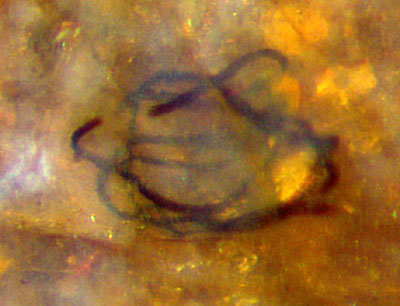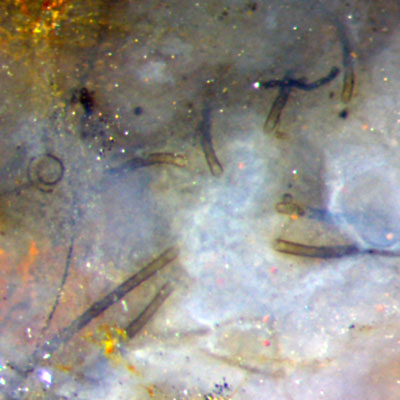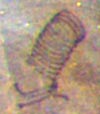Nematoplexus
- more details, more questions (2)
(revised version)

 Nematoplexus,
first described in 1961 [1], appears to become
ever more enigmatic as new details are discovered in the few fossil
samples available now. (For an
introduction see Part 1.)
Nematoplexus,
first described in 1961 [1], appears to become
ever more enigmatic as new details are discovered in the few fossil
samples available now. (For an
introduction see Part 1.)
However,
there is one detail which is seen more clearly here: While the
screw-like tubes usually "form a loose plexus and frequently appear to
lie in lax interwoven coils" [1], thus making a confusing aspect, this
sample offers the rare opportunity to see two of them separately.
Incidentally, 5 turns of the screw are seen in either case: from
outside in Fig.1 but from within in Fig.2 where one half of the thread
has been cut off so that the ends of every half turn of the tube point
out of the picture towards the observer.
The coherent tubes seen
with several turns allow to confirm the characteristic rule stated
earlier: thread diameter roughly equal to the pitch of the thread. (See
Rhynie
Chert News 29.)
 Figs.1,2 (right):
Screw-like Nematoplexus
tubes, larger than those in [1]: tube diameter about 13Ám,
Figs.1,2 (right):
Screw-like Nematoplexus
tubes, larger than those in [1]: tube diameter about 13Ám,
thread
diameter 130Ám. Width of
the images 1mm, same scale as in Part 1.
Fig.3 (left), detail of Fig.2 (below):
Smallest spiral,
apparently of different kind, thread diameter 30Ám.
Image width 0.2mm, photograph by G. Schmahl.
Small spirals as those in Figs.3,6 may be confusing among the big ones as they resemble the wall patterns of Nematothallus tubes.

Another
non-typical structure is seen in Fig.4. It looks like a piece
of wire repeatedly bent into a tangle and placed immediately below the
cut face. Some part has been cut off above left so that there seem to
be two ends. Such kind of tangle has neither been seen with Nematoplexus
nor with any other nematophyte. It differs distinctly from the
"branch-knots" since apparently no purpose can be assigned to it while
the
branch knots can bring forth more than a dozen tubes emerging
into any direction (See
Part
1.)
Fig.4 (left): Nematoplexus tube,
10Ám, bent into a tangle shaped as a coarse-meshed cage without visible
connection to other tubes. Width of the
image 0.5mm.
Fig.5 (right): 8 big slightly curved Nematoplexus
tubes with smooth wall, 25Ám,
indicating a common origin broken off here,
and vanishing from sight in the depth,
2 thin tubes, 5Ám (?), on the left, one of them screw-like, thread
diameter 90Ám,
another one slightly
curved.
Width of the image 1mm, same scale as Figs.1,2.
These pictures vizualise part of the problems encountered when trying
to make sense of the Nematoplexus
phenomenon. The
screw-like tubes in Figs.1,2 are similar to but bigger than those
in [1]. Big
slightly
curved
tubes with smooth wall, seen in
Fig.5 as a diverging bunch apparently coming from a big branch-knot in front of the picture plane, had not been seen
in the type
specimen [1]. One would be tempted to assign them to another species if
there were not the fact that they are always found near or between the
much smaller screw-like tubes. Since there are 8 of them diving into
the half space
behind the picture plane, one can assume that about the same number,
not seen here, had come towards the observer before fragmentation of the
chert layer had removed the big branch knot and exposed the tubes on
the raw surface of the sample as seen
here.

Fig.6 (left): Wall
thickenings of a big tube, short
fragment, 33Ám wide,
partially disintegrated.
As already mentioned in [1],
also tubes of various sizes with helical or annular wall thickenings, not
forming screws, are seen
scattered as
loose fragments or attached to
branch-knots. Only very narrow tubes (4-5Ám) with patterned wall have been seen emerging from a big branch-knot
where the big smooth-walled tubes (Fig.5)
come from:
Rhynie
Chert News 135.
All presently availabe pieces of information about Nematoplexus
taken together do not make a consistent view. As long as it is not
known in which
way the tubes of various type, shape, and size are mutually related,
Nematoplexus
and possibly other nematophytes have to be aptly called "enigmatic
organisms". One should not be surprised if Nematoplexus would
turn out to be based on some kind of symbiosis of nematophyte species.
Sample: Rh15/79 (0.27kg), obtained from Barron
in 2014.
H.-J.
Weiss
2016
2018 2020
[1]
A.G. Lyon:
On the fragmentary remains of an organism referable to the
nematophytales,
from the Rhynie chert, Nematoplexus
rhyniensis.
Trans. Roy. Soc. Edinburgh
65(1961-62), 79-87, 2 plates. (Scale error on Plate I Fig.1: not x19 but x1.5)
 |
 |
102 |



 Nematoplexus,
first described in 1961 [1], appears to become
ever more enigmatic as new details are discovered in the few fossil
samples available now. (For an
introduction see Part 1.)
Nematoplexus,
first described in 1961 [1], appears to become
ever more enigmatic as new details are discovered in the few fossil
samples available now. (For an
introduction see Part 1.)  Figs.1,2 (right):
Screw-like Nematoplexus
tubes, larger than those in [1]: tube diameter about 13Ám,
Figs.1,2 (right):
Screw-like Nematoplexus
tubes, larger than those in [1]: tube diameter about 13Ám, 



